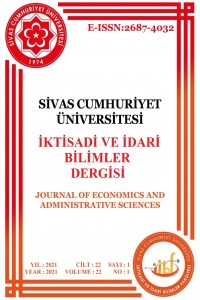Abstract
Mobil ticaretin gelişmesinde önemli yeri olan mobil cüzdanların tüketicilerce benimsenmesi ve yaygınlaştırılmasına yönelik literatürde bir çok akademik çalışma bulunmaktadır. Bu çalışmada ise mobil cüzdanların benimsenmesi konusunda yapılmış olan akademik çalışmaların Kırgızistan örneği ile genişletilmesi istenmektedir. Araştırmanın temel amacı Teknoloji Kabul Modeli çerçevesinde tüketicilerin mobil cüzdan kullanım niyetlerini etkileyen faktörleri incelemek ve kullanıcı sayısını artırmaya yönelik öneriler sunmaktır. Çalışmanın kapsamı Kırgızistan-Türkiye Manas Üniversitesi’nde lisans düzeyinde öğrenim görmekte olan öğrencilerden (n=338) oluşmaktadır. Veriler anket formu kullanılarak ve öğrencilerle yüz yüze gelerek elde edilmiştir. Yapılan analizlerin sonucunda; algılanan kullanışlılık, algılanan kullanım kolaylığı ve güven boyutlarının kullanım niyeti üzerinde etkili olduğu tespit edilmiştir. Tüketicilerin mobil cüzdan kullanım düzeylerini artırmak isteyen firmaların sözkonusu faktörleri dikkate almaları önem taşımaktadır.
References
- Aydın, G. & Burnaz, S. (2016). Adoption of mobile payment systems: a study on mobile wallets. Journal of Business Economics and Finance, 5(3), 73-92. doı: 10.17261/pressacademia.2016116555.
- Chatterjee, D. & Bolar, K. (2019). Determinants of mobile wallet intentions to use: the mental cost erspective. International Journal of Human–Computer Interaction, 35(10), 859-869. doi:10.1080/10447318.2018.1505697.
- Davis, F.D. (1989). Perceived usefulness, perceived ease of use, and user acceptance of information technology. MIS Quarterly, 13(3), 319-340. doi: 10.2307/249008.
- Davis, F.D.; Bagozzi, R.P. & Warshaw, P.R. (1989). User acceptance of computer technology: a comparison of two theoretical models, Management Science, 35(8), 982-1003.
- Gefen, D., Karahanna, E., & Straub, D. (2003). Trust and TAM in online shopping: an integrated model. Management Information Systems Quarterly, 27(1), 51-90. doi: 10.2307/30036519.
- Hamutoğlu, N. B. (2018). Bulut bilişim teknolojileri kabul modeli 3: ölçek uyarlama çalışması. Sakarya University Journal of Education, 8(2), 8-25. doi: 10.19126/suje.297586.
- Hovland, C. I., & Weiss, W. (1951). The influence of source credibility on communication effectiveness. Public Opinion Quarterly, 15(4), 635–650. doi.org/10.1086/266350
- İsmailova, R., & Muhametjanova, G. (2018). Determınants of intention to use government web sites in Kyrgyz Republic. International Journal Of eBusıness and eGovernment Studies, 10 (2), 30-45.
- İşler, B., & Gülaç, H. (2017). Mobil ödemeler, güvenlik sorunları ve çözüm önerileri. Journal of BRSA Banking & Financial Markets, 11(2), 53-86.
- Kalyoncuoğlu, S. (2018). Tüketicilerin online alışverişlerindeki sanal kart kullanımlarının teknoloji kabul modeli ile incelenmesi. Afyon Kocatepe University Journal of Social Sciences, 20(2), 193-213. https://doi.org/10.32709/akusosbil.434874.
- Liébana-Cabanillas, F.J., Sánchez-Fernández, J., & Muñoz-Leiva, F. (2014). Role of gender on acceptance of mobile payment. Industrial Management and Data Systems, 114, 220-240. doı: 10.1108/ımds-03-2013-0137.
- Matemba, E. D., & Li, G. (2018). Consumers' willingness to adopt and use WeChat wallet: an empirical study in South Africa. Technology in Society, 53, 55-68 . doi.org/10.1016/j.techsoc.2017.12.001.
- Megadewandanu, S., Suyoto, S., & Pranowo, P. (2016). Exploring mobile wallet adoption in Indonesia using UTAUT2: An approach from consumer perspective, 11-16. doı: 10.1109/ICSTC.2016.7877340.
- Özbek, V., Alnıaçık, F., Koç, E., Akkılıç, E. & Kaş. (2014). İnternet banking adoption: integrating technology acceptance model and trust. Procedia Social and Behavioral Sciences, 2 (1), 541-549.
- Rouibah, K., Lowry, B:P., & Hwang, Y. (2016). The effects of perceived enjoyment and perceived risks on trust formation and intentions to use online payment systems: new perspectives from an Arab country. Electronic Commerce Research and Applications, 19, 33–43. doi.org/10.1016/j.elerap.2016.07.001.
- Sarısakal, M. & Aydın, M. (2003). E-ticaretin yeni yüzü mobil ticaret. JAST, 1(2), 83-90.
- Shankar, A., & Datta, B. (2018). Factors affecting mobile payment adoption intention: an Indian perspective. Global Business Review, 19(3), 72–S89. doi.org/10.1177/0972150918757870.
- Shaw, B., & Kesharwani, A. (2019). Moderatin g effect of smartphone addiction on mobile wallet payment adoption. Journal of Internet Commerce, 18(3), 291-309. doi: 10.1080/15332861.2019.1620045.
- Shaw, N. (2014). The mediating influence of trust in the adoption of the mobile wallet. Journal of Retailing and Consumer Services, 21(4), 449-459. doi: 10.1016/j.jretconser.2014.03.008.
- Shin, D-H. (2009). Towards an understanding of the consumer acceptance of mobile wallet. Computers in Human Behavior, 25(6), 1343-1354. doi.org/10.1016/j.chb.2009.06.001.
- Sinha, N. & Singh, N. (2019). Understanding technology readiness and user's perceived satisfaction with mobile wallets services in India. Published in NMIMS management review, 37(3), 10-33.
- Singh, N., Srivastava, S., & Sinha, N. (2017). Consumer preference and satisfaction of M-Wallets: a study on North Indian consumers. International Journal of Bank Marketing, 35(6), 944-965. doi.org/10.1108/IJBM-06-2016-0086.
- Venkatesh, V., & Bala, H. (2008). Technology acceptance model 3 and a research agenda on ınterventions. Decision Sciences, 39(2), 273-315. doi: 10.1111/j.1540-5915.2008.00192.x.
- Uygun, M., Divanoğlu, S.U., & Özçifçi, V. (2018). Mobil pazarlama uygulamalarina yönelik tüketici kabulünü etkileyen faktörler. Organizasyon ve Yönetim Bilimleri Dergisi, 4(2), 1309-8039.
- Yongmeng, Z. (2013). Determinants of the adoption of mobile payment in China’s 3G market, (PhD Dissertation), Sun Yat-sen University, People’s Republic of China, Guangdong.
- Yousafzai, S.Y., Foxall, G.R., & Pallister, J.G. (2007). Technology acceptance: a-meta analysis of the TAM: part 1. Journal of Modelling in Management, 2(3), 251-280. doi:10.1108/17465660710834453.
- Zhanga, L., Zhua, J. & Liu, Q. (2012). A meta-analysis of mobile commerce adoption and the moderating effect of culture, Computers in Human Behavior, 28(5), 1902-1911. http://oidb.manas.edu.kg/lisans.php: 25.11.2019.
- http://www.surveysystem.com/sscalc.htm: 25.11.2019.
- https://www.statista.com/statistics/330695/number-of-smartphone-users-worldwide/: 17.01.2020.
Details
| Primary Language | Turkish |
|---|---|
| Subjects | Business Administration |
| Journal Section | Makaleler |
| Authors | |
| Publication Date | May 7, 2021 |
| Submission Date | May 27, 2020 |
| Published in Issue | Year 2021 Volume: 22 Issue: 1 |
Cumhuriyet University Journal of Economics and Administrative Sciences is licensed under a Creative Commons Attribution-NonCommercial 4.0 International License (CC BY NC).

